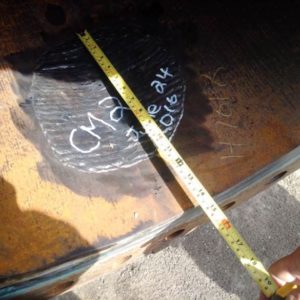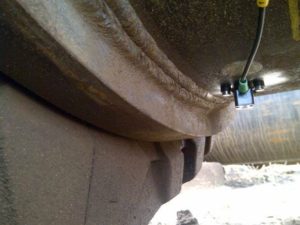In slurry transport systems a common problem is what is called Leading Edge Panning wear.

A small high wear area appears just downstream of the coupler at the 6:00 position at the leading edge of a spool. This wear spot is often 12 to 25 cm long and 12 to 18 cm wide and the wear rate in this spot has been measured to be up to 3 times as high as wear rate at the 6:00 position about 100 cm downstream. The shape of this wear spot is like a shallow dish – hence the name dishing.
It is believed that this high wear phenomena in a settling slurry transport systems is related to mismatch of the bore ID at the coupling.
- If the bore has an up-step on the leading edge of the downstream pipe, then the slurry flowing along the bottom of the pipe will plane the rise off until it is smooth and then it will carry on wearing normally.
- If the bore has a down step, then simulations show that an eddy flow happens downstream of the step that initially reduces the near surface velocity but at the end of this eddy, there is a vertical component of the flow that causes particles to impact the area with greater energy causing the panning just downstream of the step.
- The placement of the panning, is probably generally related to the size of the step and the flow velocity.
- The length of the panning may be affected by changes in flow velocity or the D50 mix of slurry near the 6:00 position.
This panning problem often leads to a holeout that is not expected based on the general wear rate along the 6:00 of the pipe. Depending on maintenance strategy to repair panning, this can lead to early replacement of the spool.
PIP360 24 sensor ring measures the wear rates on a circumferential array of 24 sensors that is placed from 1 to 2 meters downstream of the LE coupler. The instrument was specially designed with additional spot sensor channels so that a sensor can be placed at the 6:00 position just downstream of the coupler. After a spool is rotated, a new LE sensor is placed at the new 6:00 position.
PIP360 24 sensor station with Leading Edge sensor.

Leading Edge Sensor at 6:00 position just downstream of coupler.

The PIPVIEW analysis application compares the wear rate at the leading edge sensor with the wear rate at the 6:00 position at the sensor ring location. If the wear rate at the leading edge is more than 125% higher, then it flags the formation of a LE panning event. Weekly reports can predict when the panning event will reach the minimum thickness threshold so that a weld buildup can be prescribed at a convenient scheduled outage and save the spool and avoid a holeout and emergency shutdown.
The PIPVIEW Chart below shows the LE wear rate is 206% of the 6:00 wear rate 1.8m downstream.
The colored triangles show the predicted LE thickness at the colored dates.
This leading edge panning can happen on all types of spool material including rubber and urethane lined pipe. It is most common at a transition of pipe material types like from CCO to CS. This panning can happen on a spool downstream of one that was rotated so that the new thickness at the DS end of the rotated spool is more than the present thickness of the non-rotated downstream spool.

